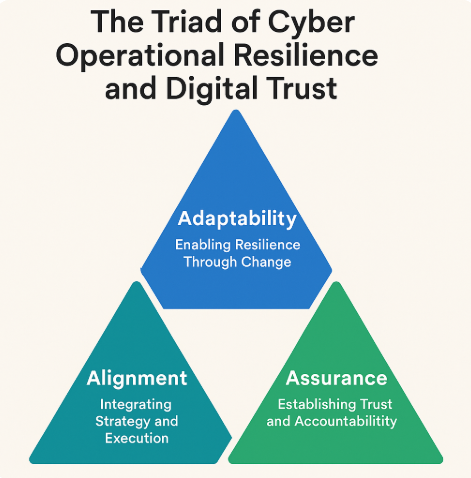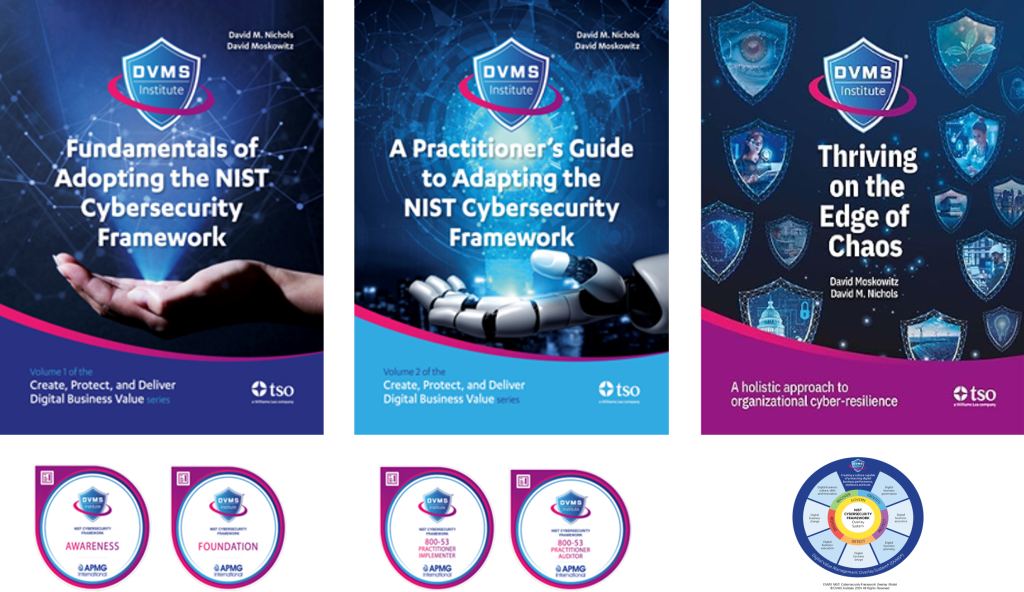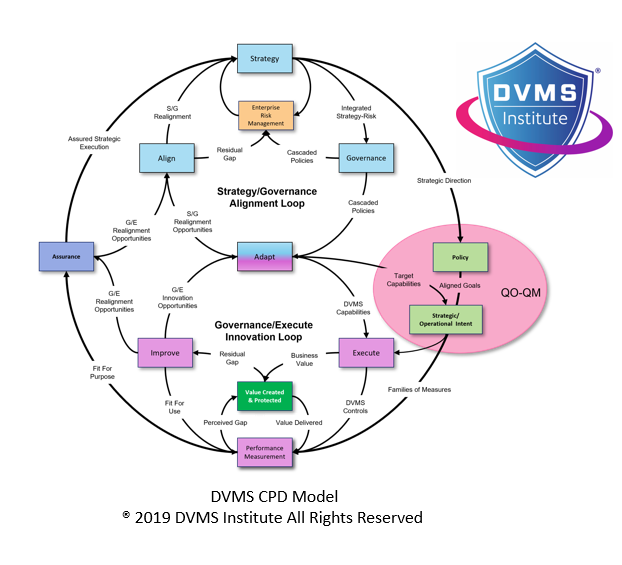Adaptability, Alignment, and Assurance (AAA)- The Triad of Cyber Operational Resilience and Digital Trust
Rick Lemieux – Co-Founder and Chief Product Officer of the DVMS Institute
Introduction: Framing the Challenge
The fusion of the NIST Cybersecurity Framework (CSF) 2.0 with the Digital Value Management System (DVMS) represents a powerful convergence of governance, resilience, and assurance (GRA) value-driven management. In this context, Adaptability, Alignment, and Assurance are not peripheral themes—they are foundational attributes that ensure an organization not only complies with cybersecurity best practices but thrives in a digital environment defined by volatility, complexity, and relentless threats. These three capabilities form a dynamic triad essential to delivering CSF-DVMS outcomes across governance, risk management, and digital value creation.
Adaptability: Enabling Resilience Through Change
Adaptability is the bedrock of organizational resilience in the face of emerging threats, new technologies, and evolving stakeholder expectations. The DVMS defines adaptability as a core behavior within its system of systems model, enabling organizations to operate and grow within dynamic environments. This is not limited to reacting to change but anticipating and embracing it as a constant.
Within CSF 2.0, adaptability is embedded in the Tiers concept, where progression from Partial (Tier 1) to Adaptive (Tier 4) represents a journey from informal responses to agile, continuously improving practices. Adaptive organizations embed feedback loops into their risk governance processes, where every incident or system failure becomes an opportunity for learning and refinement.
In the DVMS Z-X Model, adaptability is most explicitly addressed through the “Change” and “Innovate” capabilities. The “Change” capability supports transformation through feedback, iteration, and learning, while the “Innovate” capability drives sustainable improvement through experimentation and disruptive thinking. This aligns with the CPD (Create, Protect, Deliver) Model, which views adaptability as essential to concurrently managing value creation and protection, thus achieving true cyber resilience.
Adaptability also underpins the DVMS FastTrack™ approach, which breaks down digital risk management into manageable phases—Initiate, Basic Hygiene, Expand, and Innovate. This phased approach allows organizations to iteratively build cybersecurity maturity based on their context, enabling continual evolution rather than static compliance.
Alignment: Integrating Strategy and Execution
Alignment ensures that cybersecurity efforts support, rather than hinder, the organization’s broader strategic goals. In the CSF-DVMS context, alignment means synchronizing strategic risk priorities with operational capabilities across all organizational levels.
The CSF explicitly encourages using Organizational Profiles—Current and Target—to assess and prioritize cybersecurity outcomes aligned with mission objectives and stakeholder expectations. It offers a mechanism for organizations to tailor their cybersecurity activities to their unique threat landscape and business context, ensuring alignment between cybersecurity practices and desired business outcomes.
DVMS enhances this alignment through its core innovation: treating strategy and risk as inseparable—a unified entity called “strategy-risk.” Rather than viewing risk as a counterweight to ambition, DVMS embeds it directly into planning and operational execution. This paradigm shift ensures that value creation is risk-informed, and that protection is not an afterthought but a parallel, proactive endeavor.
The Z-X Model of the DVMS formalizes this alignment through the “Plan,” “Govern,” and “Assure” capabilities. “Plan” ensures that strategic intent is articulated clearly and iteratively across the organization. “Govern” sets the boundaries and policies, while “Assure” confirms execution integrity. Furthermore, the CPD Model’s integration of the 3D Knowledge Model—spanning team knowledge, collaboration, and strategic alignment—ensures that decisions and actions reflect the real-world dynamics of how organizations create and deliver digital business value.
QO–QM (Question-Outcome–Question-Metric), a derivative of GQM+Strategies used in DVMS, provides a structured approach to aligning organizational goals with measurable cybersecurity outcomes. This ensures that measurement supports strategy and that data-driven insights drive governance and improvement decisions.
Assurance: Establishing Trust and Accountability
Assurance in the CSF-DVMS model refers to validating that systems, controls, and behaviors operate as intended and supporting strategic outcomes. It is the evidence-based process of building confidence in an organization’s ability to manage digital risk, protect value, and uphold stakeholder trust.
In CSF 2.0, assurance is woven through every Function—GOVERN, IDENTIFY, PROTECT, DETECT, RESPOND, and RECOVER. The GOVERN Function emphasizes roles, policies, oversight, and accountability that set the foundation for ensuring cybersecurity risk management supports broader enterprise risk management (ERM) strategies.
DVMS elevates this by embedding assurance as one of its seven minimum viable capabilities. The “Assure” capability actively monitors conformance to policy and verifies whether the organization delivers the proper outcomes correctly. It creates feedback mechanisms to measure performance against expectations and continuously improve based on validated evidence.
More than compliance, assurance in the DVMS model is a cultural imperative. It emphasizes learning, transparency, and psychological safety—key components of a resilient and adaptable organization. The cultural web introduced in DVMS literature—symbols, rituals, power structures, control systems—reinforces that assurance is both technical and behavioral.
By integrating assurance practices with metrics-driven frameworks like GQM and QO-QM, organizations validate their progress and reinforce trust internally and externally. This trust becomes a strategic asset, particularly when organizations communicate their cybersecurity posture through Target Profiles and shared outcomes with suppliers, customers, and regulators.
Conclusion: The Triad as a Strategic Imperative
Adaptability, Alignment, and Assurance are not standalone initiatives—they form a strategic triad that enables organizations to operationalize the CSF through the lens of DVMS. Adaptability equips the organization to thrive amid disruption; alignment ensures cybersecurity actions serve broader strategic goals; and assurance validates execution while fostering trust and transparency.
These three principles define a modern, resilient approach to cybersecurity governance. They transform compliance from a cost center into a competitive advantage and reposition cybersecurity from a technical problem to an enterprise opportunity.
By leveraging this integrated model, organizations can move beyond “check-the-box” cybersecurity toward a resilient, value-protecting, and continuously evolving digital business strategy. This is not just a roadmap for survival but a strategy for thriving on the edge of chaos.
About the Author

Rick Lemieux
Co-Founder and Chief Product Officer of the DVMS Institute
Rick has 40+ years of passion and experience creating solutions to give organizations a competitive edge in their service markets. In 2015, Rick was identified as one of the top five IT Entrepreneurs in the State of Rhode Island by the TECH 10 awards for developing innovative training and mentoring solutions for boards, senior executives, and operational stakeholders.
In today’s digitally driven economy, cyber disruptions are no longer an “if” but a “when.”
The DVMS Institute’s Certified Training Programs teach organizations the skills to build and operate a Holistic, Adaptive, and Culture Aligned System capable of coordinating Cyber Operational Resilience actions across an enterprise’s complex, Digital Ecosystem.
True cyber resilience requires the seamless alignment of Strategy, Governance, and Operations across an enterprise digital ecosystem. That alignment is supported by a Leadership Team and culture committed to sustaining digital business operations and value.
The DVMS positions cyber resilience not as a technical function but as a strategic, enterprise-wide responsibility. This systems-based approach, built around the Institute’s CPD, Z-X, and 3D Knowledge models, mandates engagement from top executives, frontline employees, and ecosystem partners, each playing a distinct role in identifying, classifying, and mitigating the systemic risks that threaten digital value and organizational resilience.
This adaptive, forward-looking approach to Governance, Resilience, and Assurance (GRA) positions your business to:
- Maintain Operational Stability Amidst Constant Digital Disruption
- Drive Agility and Trust Across Your Digital Ecosystem
- Satisfy Critical Regulatory and Certification Requirements (SEC, NIS2, DORA, etc.)
- Leverage Cyber Resilience as a Competitive Advantage
DVMS Module Explainer Videos
- DVMS Architecture Video: David Moskowitz explains the DVMS System
- DVMS Case Study Video: Dr. Joseph Baugh Shares His DVMS Story.
- Overlay Model – Using existing systems to power operational resilience
- ZX Model – The business capabilities that power operational resilience
- CPD Model – Adaptable governance & assurance across the enterprise
- 3D Knowledge Model – Enabling holistic organizational learning
- FastTrack Model – A phased approach to adapting a NIST-CSF-DVMS
Digital Value Management System® is a registered trademark of the DVMS Institute LLC.
® DVMS Institute 2025 All Rights Reserved




